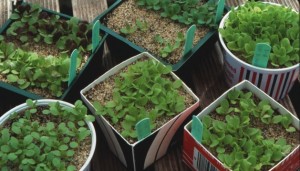It’s no surprise that Jack (of fairy tale fame) was traded “magic” seeds for his cow. By their very nature, seeds are magical. They’ve laid dormant, just waiting for the right conditions to come along so they can burst forth with entertaining growth and continue the fanfare to a summer long display of flowers or vegetables.
Seeds let you start at the beginning. It’s a satisfying, personal involvement that starts with your decision of which seeds to grow. Seed catalogs and seed packet displays offer you a much wider selection of flowers and vegetables than you will find among started plants. You get to choose exactly which plants you will end up with – size, shape, color and even the name you like. Seeds are inexpensive, so you can afford to “try something new,” or go a little “crazy” and buy all your favorites.
Seeds are as “natural” as you can get. You can watch their life cycle from beginning to end. Even if you aren’t an aggressive recycler, seeds naturally lend themselves to being started in egg cartons or other “throw away” containers that let you feel good about what you are doing.
For most of us, seeds take only a little time each day to be cared for properly, fitting into even the most active schedules. They comprise the almost ideal hobby, needing little time, little money, and returning tremendous rewards in relaxation and satisfaction.
Decisions, Decisions
Perhaps the most difficult part of growing seeds is making the selections. If you are planning to grow vegetables you need to first decide what vegetables and then what varieties. A review of your personal and your family’s likes and dislikes will probably narrow the list quickly.
Choosing flowers requires a lot of decisions – but you can “mix and match and choose” to fit a wide range of options. Basically, you need to decide if the flower will ultimately be planted in full-sun, partial-sun or shady location. Seed packets and catalog descriptions will tell you the light requirements for a particular class and variety.
Starting Indoors
Read the packet instructions on when to plant indoors. Generally, you will want to start six to eight weeks before the “final frost” date in your area.
After the seeds, the first thing you will need is a container to grow them in. The best containers are those made for the purpose. There are seed starting containers made of plastic or pressed fiber, peat strips and pots, and peat pellets of different types, as well as growing cubes and even complete seed-starter kits available. You can base your choice on price, convenience and even curiosity to decide which to use.
If you use your own containers (even the ones you used last year), be sure they are thoroughly washed to make them as sterile as possible. A few days in the sun after washing is a good idea.
Drainage is important. Containers made for seed sowing will come with drainage holes. If you use recyclables such as egg cartons or cans, be sure to punch drainage holes in the bottom.
Germinating Media
For seed starting, the best choice is a sterile, soilless germinating mixture that you can buy at the store. Although garden soil might seem like a good idea for starting seeds, it isn’t.
Sowing Seeds
Dry growing mix is difficult to wet completely, so before filling your containers put the mixture in a plastic bag and thoroughly wet it by kneading to your heart’s content. Then fill your containers with the mix to about one-quarter inch from the top and let them sit for a while. Drain off any excess water. If you are using peat pots, water them thoroughly first, and then fill with the moist mix. Pat the moist mix down firmly, flattening it with a spoon or label. Nothing is perfect, and you will have to face the fact that not every seed will germinate. Plus you might lose a plant or two when you transplant, so you will need to sow more seeds (double is a good bet) than you actually think you want.
Large seeds can be easily handled and placed individually in the mix. Smaller seeds can be sown by snipping off a corner of the seed packet and tapping them gently out of the packet as you sow them. If too many seeds fall out at once, gently spread them with the tip of a pencil. Seeds need room to grow, so don’t plant them too thickly. Place two large seeds and two to three small seeds in each container where you want at least one plant to grow.

Leave a Reply
You must be logged in to post a comment.